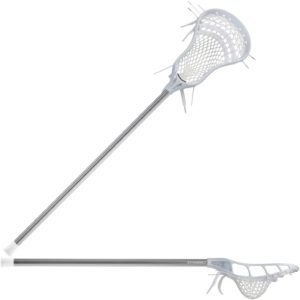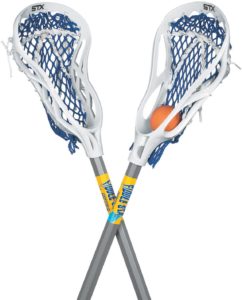Lacrosse sticks are the most important piece of equipment for a lacrosse player. The right lacrosse stick for beginners will have an outsized impact on learning and mastering key skills like passing, catching, and cradling. For those new to the sport, figuring out which stick to purchase can be overwhelming. Below is a breakdown of the basics that you need to know, along with our top recommended lacrosse sticks for beginners.
- TLDR: Which lacrosse stick should I get?
- Ages 10 and under: Warrior Burn Junior
- Ages 10-14: Warrior Burn Next
- Youth players with some experience (10-12): STX Stallion 50 Youth
- Experienced youth players (12+): STX Stallion 200
- Highest quality pocket (all ages): StringKing Complete 2
- Casual backyard play: STX Mini Lacrosse Sticks
- Lacrosse Stick Parts
- Shaft (aka pole)
- Head
The first thing you should know about lacrosse sticks is that they are composed of multiple parts. The term “Lacrosse stick” refers to these 3 parts when they are attached together.
- The shaft (the actual pole, usually made of a lightweight metal or carbon fiber)
- The head (the plastic on top of the shaft that’s used to carry the ball, and is strung with a ‘pocket’)
- The pocket (the mesh stringing that attaches to the head to provide control while carrying, catching, or passing the ball)
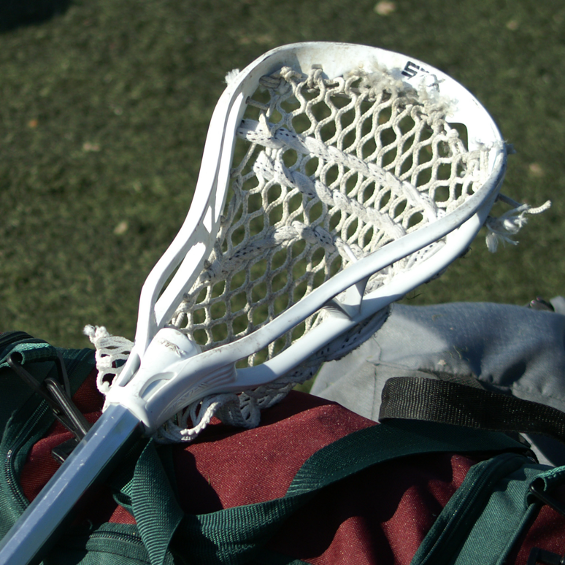
Table of Contents
Information About Lacrosse Sticks For Beginners
What are complete lacrosse sticks?
When lacrosse players reach a certain skill level, they usually purchase these parts separately in order to customize the stick to their specific liking. But when you’re trying the game for the first time, purchasing them separately can become expensive and tedious.
This is why some stick manufacturers offer what’s known as “complete lacrosse sticks” for beginners, especially at the youth level. Complete sticks have a shaft, head, and pocket pre-assembled and geared toward entry level players at very affordable price points (~$50 or so, as compared to individual heads and shafts which can cost upwards of $100-$150 each).
Purchasing a complete lacrosse stick is an affordable and hassle-free way to get started with the sport. There are relatively few options to consider, and it provides an easy entry point for beginners before making a larger financial investment.
Are adult and youth lacrosse sticks different?
The component parts of adult and youth lacrosse sticks are exactly the same. The one major difference is in stick length. Basically, youth players are free to use adult sticks but adults are restricted from using shorter youth sticks.
A standard men’s lacrosse stick must be at least 40 inches in length, but this can be a bit large and heavy for youth players. For that reason, players under 10 are allowed to use sticks as short as 36 inches when playing competitively. It is possible to buy an adult-sized stick and just cut off a few inches, but sticks designed for youth players are not just shorter–they are often less heavy, narrower in circumference, and more affordable. This is true not only of the shaft part, but of the head as well.
Do different lacrosse positions require different sticks?
At the youth level, no. For youth lacrosse sticks, the top priority is just to make sure you’re comfortable with the length of your stick so that you can control it effectively.
At the adult level of men’s lacrosse, however, stick length does vary by position. Attackmen and most midfielders use a shorter stick (40-42 inches) for easy maneuvering; defensemen usually opt for a longer stick (52-72 inches) for range and coverage; and goalies can use a stick that’s anywhere from 40-72 inches.
Other aspects of the lacrosse stick can vary according to position as well: goalies use much larger heads than players at any other position, for instance. Players can customize just about any feature of their lacrosse stick. Pocket depth, head shape, stick length–you can get very specific with your preferences at the adult level.
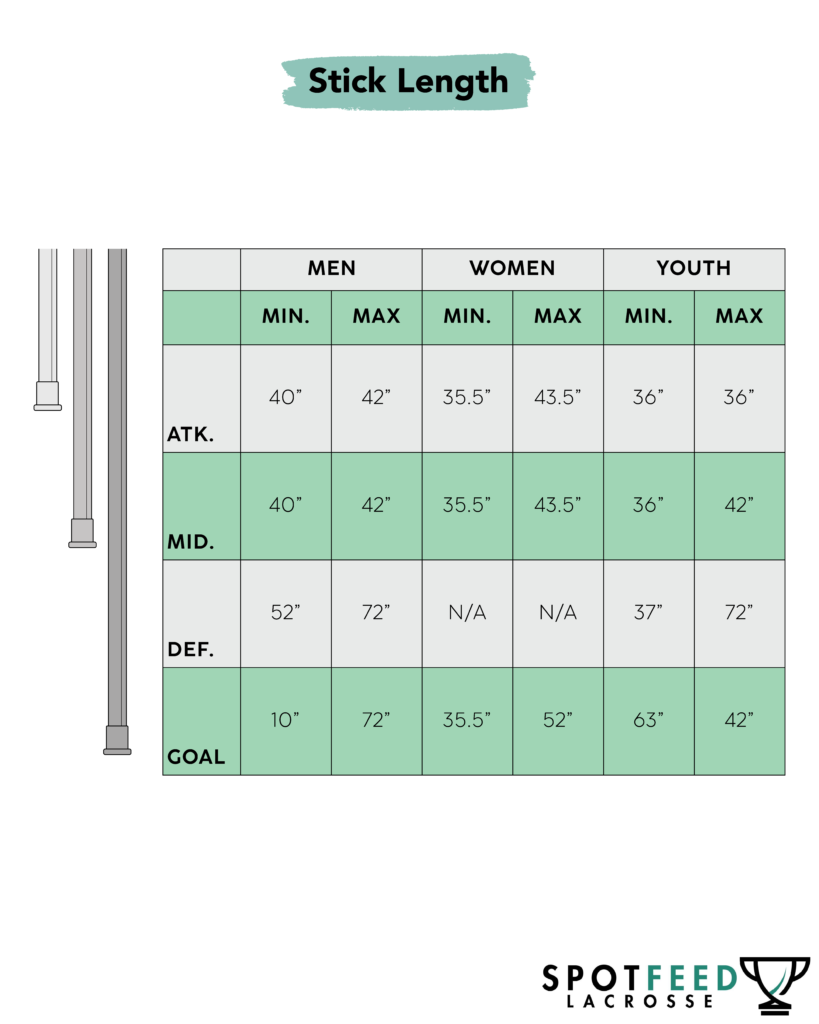
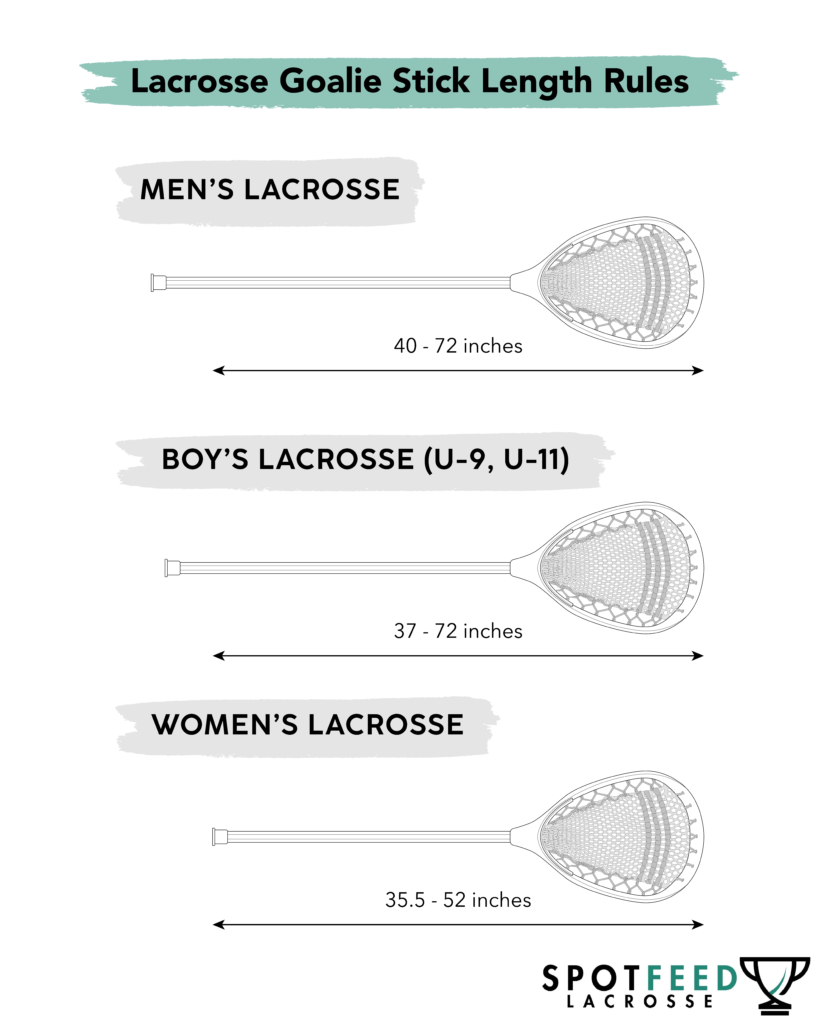
Warrior Burn Junior
Pros
- Short and lightweight
- Highly affordable
- Wide head makes catching passes and ground ball pickups easier for beginners
Cons
- Not legal for players older than 10
This is an ideal option for youth players (10 years or younger).
The Warrior Burn Junior stick is advertised as 37 inches long in total (top of the head to bottom of the shaft) and its head is advertised on Warrior’s website as having a “wider face shape for increased catching surface and easier groundball pick-ups.”
Since catching and picking up the ball from the ground are arguably the two most important basic lacrosse skills, this is a really nice feature for beginner players. The mesh pocket is also described as being “strung to improve hold and provide an accurate release,” another feature that makes handling the ball easier for beginners.
Finally, this stick is easily available on Amazon and other online retailers, but seems less easy to find at brick-and-mortar stores. Luckily, the Warrior website has a store locator feature so that you can see what’s available in your area. If you are happy with the convenience of ordering online, this might be the stick for you, but if you prefer to touch and feel equipment in a store before buying anything, you might want to check out one of these other options.
Buying Options
Warrior Burn Next
Pros
- Versatile stick that can be used for many years
- Legal for youth, high school, and college play
- Slightly narrower head for better ball handling
- Available with attack or defense shaft
Cons
- May be a bit long or heavy for players under 12
The Warrior Burn Next is, as the name suggests, just a slightly upgraded version of the Burn Junior designed for players who are more than 10 years old and/or a bit more advanced in skill and experience.
At 40 inches in length, it is legal to use at the high school and even college levels, but can also be used at the youth level for those players who might be large and strong enough to handle a full-sized lacrosse stick. Since it’s not uncommon for players to use the same stick for 5 or 6+ years, this lacrosse stick can last a while.
Its head design makes it easy to pickup ground balls, but the shape is slightly more narrow than that of the Burn Junior. The width of any head usually has a tradeoff between ease of catching and ease of handling. Wider heads give you more room for error when trying to make a catch, but have the disadvantage of extra room for the ball to move around while cradling, passing, or shooting. That is why intermediate players, who have gotten comfortable with catching and therefore no longer need the extra width, might benefit from a slightly narrower head that “improves ball control and accuracy,” as Warrior’s product description puts it.
The other difference between the Junior and Next models is that the Burn Next is available both as an offensive stick (for attack and midfield players) and a defense stick, which are longer (54-72 inches).
STX Stallion 50 Youth
Pros
- Highly affordable
- High quality head for youth stick
- Available with attack or defense shaft
Cons
- Not the best fit for true beginners
The STX Stallion 50 Youth lacrosse stick is a great beginner / intermediate combo. The stick length is 39 inches, making it an interesting in-between option. Like other youth lacrosse sticks, it is not legal for high school or college play, but it is on the cusp at just one inch shorter than legal length for those more advanced levels.
For youth players, this makes the eventual jump from an undersized stick to a full-sized one a lot smoother. Paralleling this balance between youth and intermediate qualities is the head, which is youth-sized but, according to STX, “inspired by the elite Stallion 550 head.” This head is advertised as having a “mid-high pocket,” which makes keeping the ball in the stick a bit more difficult but provides a quicker release to passes and shots.
You don’t need to get bogged down in the details of lacrosse heads just yet, but the point is that the Stallion 50 marries the benefits of a youth stick (like the Warrior Burn Junior) with some of the benefits of a more advanced head (like those being used at the high school and collegiate levels).
This is therefore a great option for a child 12-and-under who already has some playing experience but is still not completely ready to handle a full-sized stick.
Buying Options
STX Stallion 200
Pros
- Most popular complete lacrosse stick on the market
- Legal for youth, high school, and college play
- Available with attack or defense shaft
Cons
- Not the most youth-friendly option
This is the slightly more advanced version of the Stallion 50, intended for players who are large, strong, or old enough to handle a standard stick that is 40 inches long (for the attack/midfield version), and ready for high school and college level play.
According to STX’s product description, the Stallion 200 is “the number one selling complete stick in the game.” Like the Stallion 50, it too is advertised as having a head that is designed to be friendly enough for beginners while still offering some advantages of a more elite lacrosse stick.
Adding to the appeal is its budget-friendly and competitive price. Echoing the claim of being the number one selling complete stick, both versions–offense and defense–are widely available at just about any retailer, online or in person, that sells lacrosse equipment.
Buying Options
StringKing Complete 2
Pros
- Options available for all ages and positions
- High quality mesh pocket for improved ball-handling
Cons
- A bit expensive
Rounding out the list is the StringKing Complete 2 lacrosse stick, which is widely respected as one of the best complete sticks currently on the market. This stick has a couple of advantages over its competitors: namely, wider selection of offerings and superior mesh quality.
The StringKing Complete 2 is available in Junior (38 inches, recommended for ages 9 and under), Intermediate (age 10-14), and Senior (age 15 and up). In addition to this, the Intermediate and Senior versions are available both with attack/midfield and defense options for the shaft. This makes it a great option for newcomers of all ages and playing styles.
What StringKing really prides itself on, though, is its mesh, which is deemed to be among the best on the market, not just for beginners but for players of ALL levels.
Every other stick on this list comes with cheap soft mesh, which can wear out and tear fairly quickly, especially if exposed to too much rain and other inclement weather. StringKing’s mesh is stiffer, meaning that it is more weather-resistant, lasts longer, and holds the shape of the pocket better over time, which can give players a slight leg up in terms of performance. This means that you can use this stick for a long time before you have to replace the mesh and strings, which costs money and can be tricky to do on your own.
The biggest downside of the StringKing stick is its price. That said, if you factor in the money you might save on replacement mesh and/or stringing services, its value stacks up as competitive with the rest on this list. If you’re able and willing to shell out a bit more money to snag one of these, you’ll have one of the highest quality complete sticks out there.
Buying Options
Best Backyard Lacrosse Set For Children: STX "FiddleSTX" Mini Lacrosse Sticks
Pros
- Great for total beginners as young as 3
- Easy to throw, catch, and handle
- Fun casual activity even for adults who are new to lacrosse
- Highly affordable
Cons
- Can't be used for actual games
If you are interested in trying out lacrosse, but you’re not quite convinced this will develop into any kind of long-term engagement with the sport, then mini lacrosse sticks are perfect for you. These miniature lacrosse sticks for beginners are not suitable for organized team play, but they are an easy way to try the sport in the backyard with friends.
This is a pack of two sticks and a soft orange lacrosse ball. The sticks are even shorter than youth/junior sticks and much cheaper. Great for some casual backyard play, they’re easy to throw and catch with and can be a lot of fun even if you’re not yet ready to completely dive into the sport.
Your first stick will be something you treasure for a long time and getting a stick for the first time is one of the most exciting parts of any player’s journey. So have fun with the process of selecting one!
If you want to dive a bit deeper into some of the more nuanced stick components that came up in this guide, feel free to check out some of our other guides.
FAQs
Picking a beginner lacrosse stick involves considering a few factors about yourself or your son: how old you are, what position you plan to play, and how much you’re willing to spend. Children 10 and under may not be strong enough to handle the weight of a full-sized stick and the 10 and under leagues usually allow the use of shorter sticks. Also, there is less emphasis on specialized sticks for different positions at this age, so any stick will do if it’s the right size and within your budget. For older kids (middle and high school), knowing what position you want
If your son is 10 or under, you should consider buying a youth lacrosse stick for him, since many of them are shorter (36-38 inches) and lighter than adult sticks and will be easier to handle at first. If your son is in middle or high school, the stick you buy must be at least 42 inches long. If your son wants to play defense, he will probably be using a long pole that is 72 inches long. And if he is a goalie, his stick can be anywhere between 42 and 72 inches long. If you don’t know what position your son will be playing, start with a 42-inch stick, as this will be the best length for learning fundamentals. Beginners often start out playing midfield anyway, as it can take a bit longer to learn defense and gain the strength to handle a long pole.





